UFR 4-18 Evaluation: Difference between revisions
| Line 29: | Line 29: | ||
<math>f = (0.25 + 0.1175/(P/D-1)^{1.08}) Re^{-0.16}</math> | <math>f = (0.25 + 0.1175/(P/D-1)^{1.08}) Re^{-0.16}</math> | ||
Note that the experimental results have an error of 2.5% at the higher Reynolds numbers. | Note that the experimental results have an error of +/- 2.5% at the higher Reynolds numbers. | ||
Large Eddy Simulation shows a very good agreement with the correlations and Ames et al. experimental results. The relative error is equal to 1% end 3% for the two Reynolds numbers, respectively. for both computed Reynolds numbers. The EB-RSM shows a very satisfactory pressure loss coefficient at <math>Re_D=10000</math> (1% error) but a worse pressure loss coefficient at <math>Re_D=30000</math> (10% error). The kω-SST shows globally good results (7% and 6% errors) and the φ-model poorer results with an error of 17% and 12% for the two Reynolds numbers, respectively. | Large Eddy Simulation shows a very good agreement with the correlations and Ames et al. experimental results. The relative error is equal to 1% end 3% for the two Reynolds numbers, respectively. for both computed Reynolds numbers. The EB-RSM shows a very satisfactory pressure loss coefficient at <math>Re_D=10000</math> (1% error) but a worse pressure loss coefficient at <math>Re_D=30000</math> (10% error). The kω-SST shows globally good results (7% and 6% errors) and the φ-model poorer results with an error of 17% and 12% for the two Reynolds numbers, respectively. | ||
Revision as of 12:59, 21 April 2015
Flow and heat transfer in a pin-fin array
Confined Flows
Underlying Flow Regime 4-18
Evaluation
Comparison of CFD Calculations with Experiments
Discuss how well the CFD calculations of the assessment quantities
compare with experiment and with one another. Present some key
comparisons in the form of tables or graphical plots and, where
possible, provide hyperlinks to the appropriate results database.
Results with different turbulence models covering as wide a range as
possible should be included in the discussion. However, if too many
different calculation results are available (e.g. from workshops) do
not present all the comparisons here. A selection should be made
showing results only for the most typical and practically important
models. Comprehensive comparisons can be made available via a link to
the associated databases. Finally, draw conclusions on the ability of
the models used to simulate the test case flow.
Global comparisons
Pressure loss coefficient
The following table gives the numerical values of the presure loss coefficient in Ames et al. experiment as well as those obtained in the main computations.
Figure ?? shows these values and compare them to existing correlations from the literature:
- Metzger et al. (1982) :
for , Failed to parse (syntax error): {\displaystyle f = 0.317 {Re_D}^{−0.132} } , for , Failed to parse (syntax error): {\displaystyle f = 1.76 {Re_D}^{−0.318}}
- Jacob (1938) :
Note that the experimental results have an error of +/- 2.5% at the higher Reynolds numbers. Large Eddy Simulation shows a very good agreement with the correlations and Ames et al. experimental results. The relative error is equal to 1% end 3% for the two Reynolds numbers, respectively. for both computed Reynolds numbers. The EB-RSM shows a very satisfactory pressure loss coefficient at (1% error) but a worse pressure loss coefficient at (10% error). The kω-SST shows globally good results (7% and 6% errors) and the φ-model poorer results with an error of 17% and 12% for the two Reynolds numbers, respectively.
Wall resolved LES is then the best candidate to obtain almost perfect pressure loss coefficients in the present configuration. The EB-RSM five very good results at the lowest Reynolds number but a substantial error is observed at . Although the kω-SST exhibits pretty good results, the physics of the present flow is not well captured and one can't rely on this model. The φ-model has to be avoided for the present configuration in order to compute the pressure loss coefficient.
| Ames et al. | LES3000 | Ames et al. | LES10000 | EBRSM10000 | PHI10000 | kwSST10000 | Ames et al. | EBRSM30000 | PHI30000 | kwSST30000 | |
|---|---|---|---|---|---|---|---|---|---|---|---|
| Value | 0.111 | 0.1076 | 0.095 | 0.0939 | 0.0963 | 0.0789 | 0.0883 | 0.07 | 0.0771 | 0.0615 | 0.0744 |
| Error (%) | - | 3 | - | 1 | 1 | 17 | 7 | - | 10 | 12 | 6 |
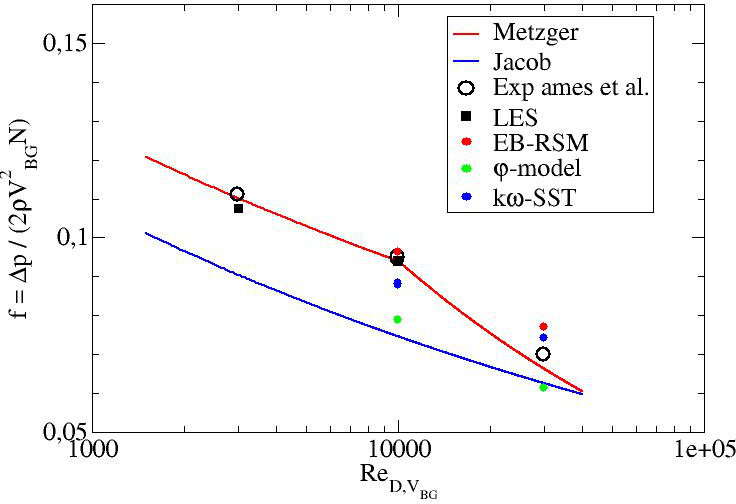
Figure ??: Pressure loss coefficient
Average Nusselt Number
The following table gives the numerical values of the average Nusselt numbers in Ames et al. experiment as well as those obtained in the main computations.
Figure ?? shows these values and compare them to existing correlations from the literature:
- Metzger et al. (1982) :
- Van Fossen (1982) :
Note that the experimental results have an error of +/- 12%, +/-11.4%, and +/-10.5% for the 3 000, 10 000, and 30 000 Reynolds numbers, respectively, in the endwall regions adjacent to the pins and +/- 9% away from the pin.
| Ames et al. 3000 | Ames et al. 10000 | Ames et al. 30000 | LES3000 | LES10000 | EBRSM10000 | PHI10000 | kwSST10000 | EBRSM30000 | PHI30000 | kwSST30000 |
|---|---|---|---|---|---|---|---|---|---|---|
| 22.1 | 54.1 | 111.5 | 21.6 | 48.6 | 48.1 | 37.6 | 33.1 | 114.8 | 93.3 | 72 |
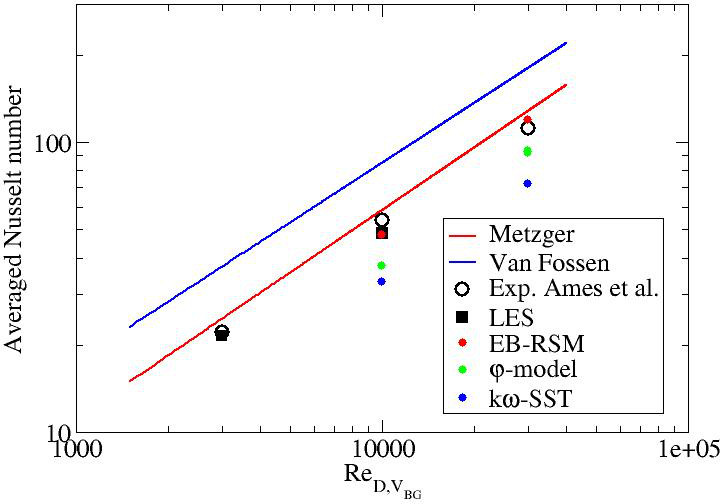
Figure ??: Averaged Nusselt number on the bottom wall
Local comparisons
Mean pressure coefficient

Figure ??: Pressure coefficient along the midline of the pins - LES at

Figure ??: Pressure coefficient along the midline of the pins - LES and URANS computations at

Figure ??: Pressure coefficient along the midline of the pins - URANS computations at
Mean velocity profiles
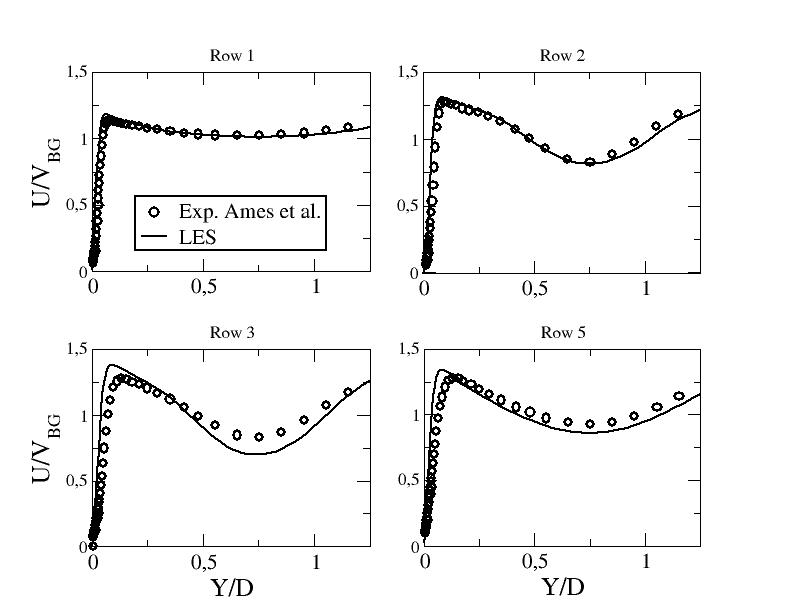
Figure ??: Mean stream-wse velocity component along line B - LES at

Figure ??: Mean stream-wse velocity component along line B - LES and URANS computations at
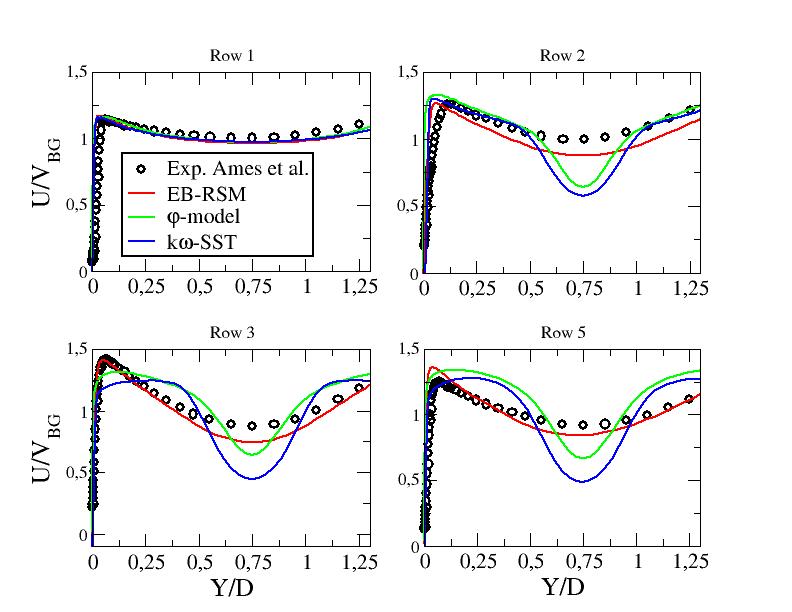
Figure ??: Mean stream-wse velocity component along line B - URANS computations at

Figure ??: Mean stream-wse velocity component along line A1 - URANS computations at
R.m.s. velocity profiles

Figure ??: R.m.s. of the stream-wise velocity component along line B - LES at

Figure ??: R.m.s. of the stream-wise velocity component along line B - LES and URANS computations at

Figure ??: Resolved and modelled contributions to the r.m.s. of the stream-wise velocity component along line B - URANS computations at

Figure ??: R.m.s. of the stream-wise velocity component along line B - URANS computations at

Figure ??: Resolved and modelled contributions to the r.m.s. of the stream-wise velocity component along line B - URANS computations at

Figure ??: R.m.s. of the stream-wise velocity component along line A1 - URANS computations at

Figure ??: Resolved and modelled contributions to the r.m.s. of the stream-wise velocity component along line A1 - URANS computations at
Nusselt number on the bottom wall

Figure ??: Local Nusselt number on the bottom wall - LES computation at vs. experimental results from Ames et al.
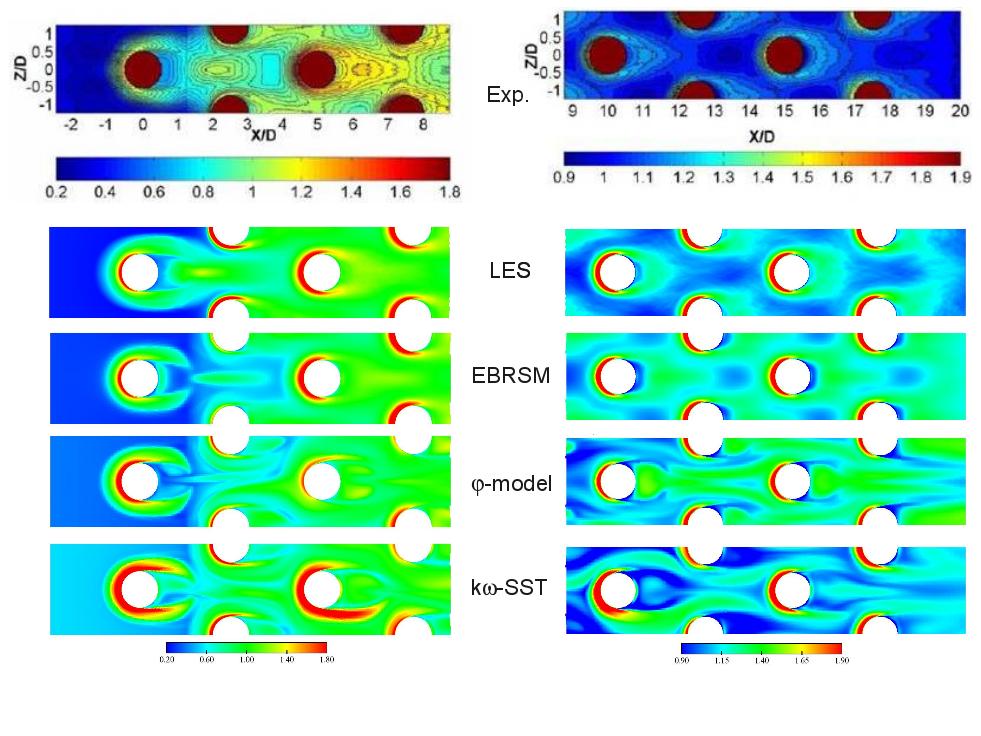
Figure ??: Local Nusselt number on the bottom wall - LES and URANS computations at vs. experimental results from Ames et al.
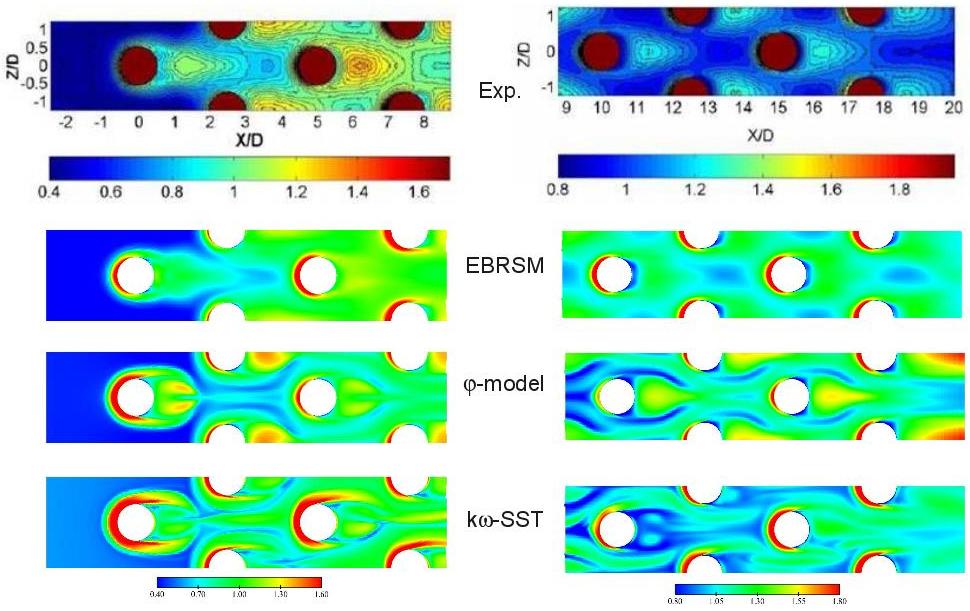
Figure ??: Local Nusselt number on the bottom wall - URANS computations at vs. experimental results from Ames et al.

Figure ??: Local Nusselt number on the bottom wall - - top: Y=0, bottom: Y=1.25 - symb.: Exp. - black: LES
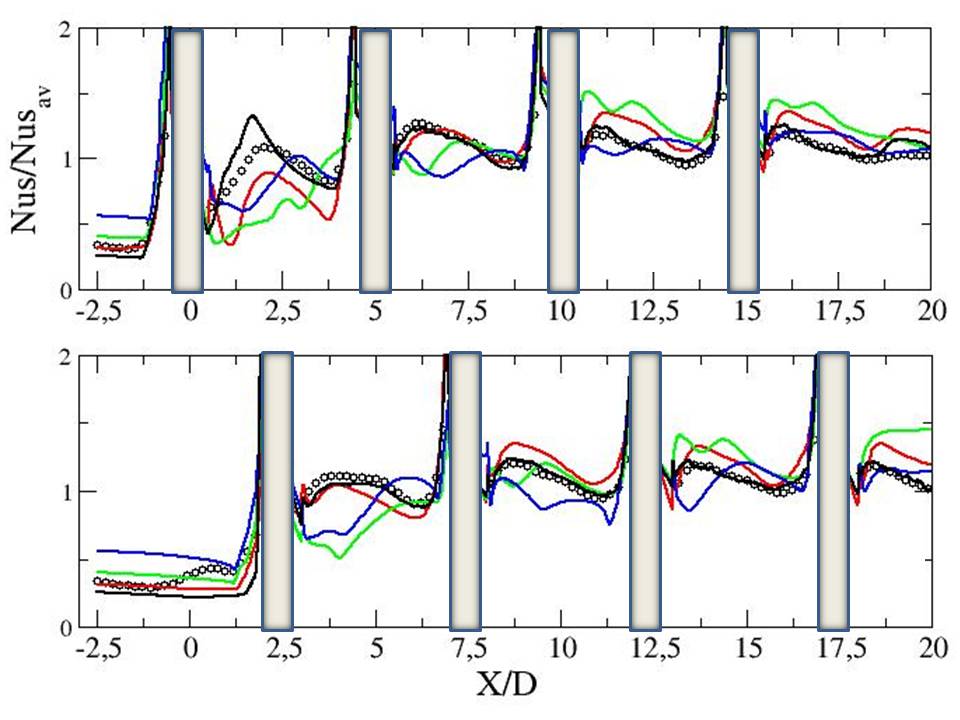
Figure ??: Local Nusselt number on the bottom wall - - top: Y=0, bottom: Y=1.25 - symb.: Exp. - black: LES - red: EBRSM - blue: Phi-model - green: kw-SST

Figure ??: Local Nusselt number on the bottom wall - - top: Y=0, bottom: Y=1.25 - symb.: Exp. - red: EBRSM - blue: Phi-model - green: kw-SST
Contributed by: Sofiane Benhamadouche — EDF
© copyright ERCOFTAC 2024







